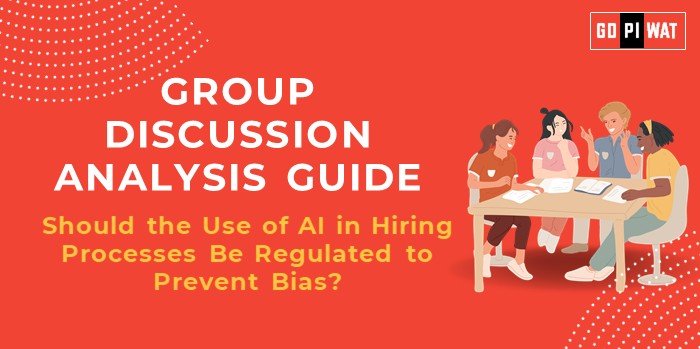📋 Group Discussion (GD) Analysis Guide: Should the Use of AI in Hiring Processes Be Regulated to Prevent Bias?
🌐 Introduction to the Topic
- Opening Context: Artificial Intelligence (AI) is increasingly used in hiring processes worldwide, leveraging automation for efficiency, but its potential to perpetuate or amplify bias is raising global concerns. This topic has significant implications for ethical hiring practices and corporate diversity.
- Topic Background: AI in hiring gained momentum as companies sought data-driven solutions to improve recruitment. Despite its promise, cases like Amazon’s AI recruiting tool, which demonstrated gender bias, highlight its challenges. Governments and organizations are exploring regulation to address these issues.
📊 Quick Facts and Key Statistics
- 📈 AI in Hiring Usage: 55% of HR professionals globally use AI tools for recruitment. (Source: SHRM, 2024)
- 📉 Bias Concerns: 67% of candidates feel AI may lead to discriminatory hiring. (Source: Pew Research, 2024)
- 💡 Cost Efficiency: AI reduces hiring costs by 30% on average. (Source: Deloitte, 2023)
- 📜 Regulations: EU’s AI Act includes provisions addressing AI bias in employment.
👥 Stakeholders and Their Roles
- 🏛️ Governments: Drafting regulations to ensure fairness in AI algorithms.
- 🏢 Corporations: Implementing AI systems while maintaining ethical hiring practices.
- 💻 Technology Developers: Ensuring algorithms are transparent and unbiased.
- 🙋♂️ Job Seekers: Advocating for equitable treatment in hiring processes.
🏆 Achievements and Challenges
✨ Achievements
- Efficiency Gains: AI reduces hiring time by 60%, improving productivity.
- Wider Reach: Algorithms analyze thousands of applications, expanding candidate pools.
- Global Models: Japan’s recruitment sector improved diversity metrics through monitored AI adoption.
⚠️ Challenges
- Bias in Algorithms: Systems trained on biased data risk discriminatory outcomes.
- Transparency Issues: Many AI models lack explainability, hindering accountability.
- International Comparisons: While the EU has regulations, the U.S. lacks comprehensive federal laws.
📖 Case Study
Amazon’s AI recruiting tool showed bias against women due to historical data reflecting male-dominated industries.
📚 Structured Arguments for Discussion
- 💪 Supporting Stance: “Regulating AI in hiring ensures fairness, prevents discrimination, and protects candidates’ rights.”
- ❌ Opposing Stance: “Regulation stifles innovation and increases costs, slowing AI adoption in hiring processes.”
- ⚖️ Balanced Perspective: “While regulation is essential to prevent bias, it should not hinder technological innovation.”
💡 Effective Discussion Approaches
- 📊 Opening Approaches:
- Start with a statistical impact: “67% of candidates fear AI discrimination; this shows the urgent need for regulation.”
- Present a case study: “Amazon’s biased AI tool highlights why oversight is crucial.”
- 🎯 Counter-Argument Handling:
- Acknowledge benefits like efficiency.
- Highlight risks with data: “Transparency concerns are valid, as only 15% of AI systems are explainable.”
🔍 Strategic Analysis of Strengths and Weaknesses
- ✅ Strengths: Increased efficiency, data-driven decision-making.
- ❌ Weaknesses: Risk of perpetuating bias, lack of global regulatory consistency.
- 🚀 Opportunities: Innovation in explainable AI, global regulatory frameworks.
- ⚠️ Threats: Legal liabilities from biased outcomes, resistance from tech developers.
🎓 Connecting with B-School Applications
- 📌 Real-World Applications: AI in hiring intersects with project themes on ethics, governance, and HR innovation.
- ❓ Sample Interview Questions:
- “How can AI improve diversity in hiring while avoiding bias?”
- “Evaluate the role of regulation in fostering ethical AI use.”
- 📘 Insights for B-School Students: Examine ethical AI use as a research theme, explore AI regulation’s impact on HR innovation.


